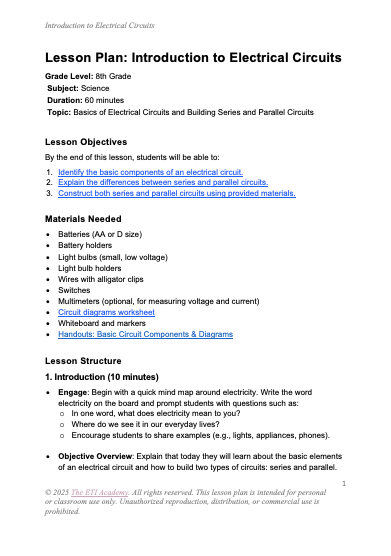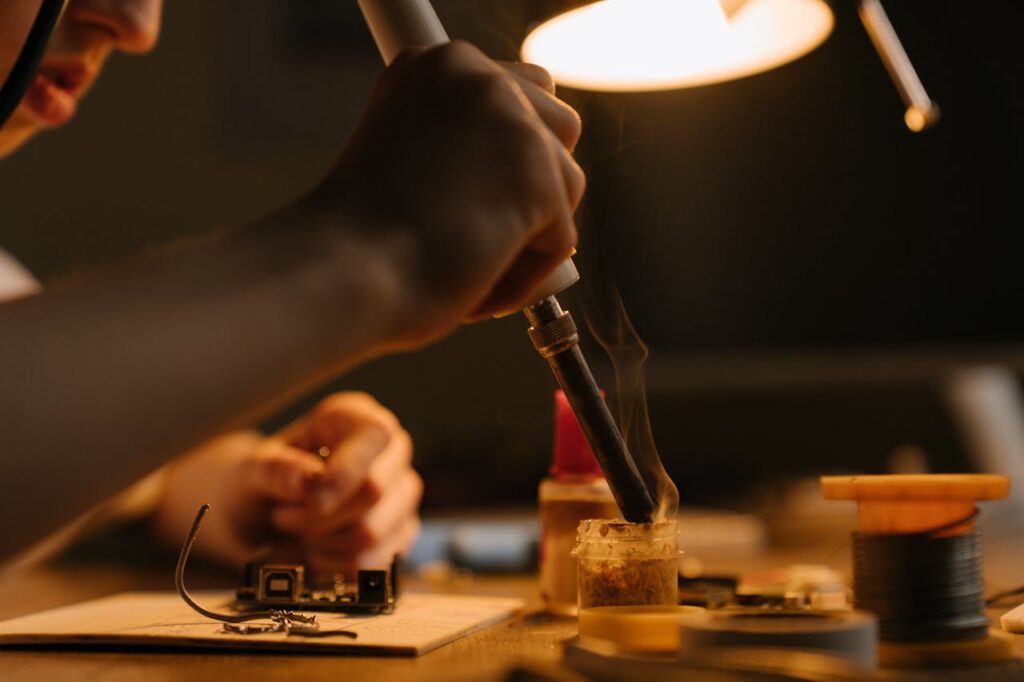Understanding Electrical Circuits: A Hands-On Guide for Homeschool Science
In this blog post, we’ll introduce a hands-on electrical circuits lesson plan for homeschool students that introduces the basics of electrical circuits and how to build both series and parallel circuits.
Learning about electricity can spark curiosity and ignite a passion for science in young learners.

As a homeschooling parent teaching your children, this guide will help you make teaching and learning about circuits both engaging and educational.
A downloadable copy of this lesson plan is available on our ETI Academy TpT Store.

[Click here to download your copy today!]
Our Electrical Circuits Lesson Plan for Homeschool Teachers
Electrical circuits are fundamental to understanding how electricity powers our world. From the lights in our homes to the gadgets we use daily, circuits are everywhere.

Teaching students about circuits at home not only builds foundational knowledge in physics but also fosters problem-solving skills and creativity.
Below is a detailed look at our lesson plan objectives, materials needed, and an introduction. For a full look at the lesson plan, visit our TpT store to download your copy today!
Lesson Objectives
By the end of this lesson, students will:
- Identify the basic components of an electrical circuit.
- Understand the differences between series and parallel circuits.
- Build and analyze both types of circuits.
What You’ll Need
Here’s a list of materials to gather for this activity:
- Batteries (AA or D size)
- Battery holders
- Light bulbs (small, low voltage)
- Light bulb holders
- Wires with alligator clips
- Switches
- Multimeters (optional, for measuring voltage and current)
- Circuit diagrams worksheet
- Handouts: Basic Circuit Components & Diagrams
Step-by-Step Lesson Plan
1. Start with the Basics (10 minutes)
Begin with a discussion about electricity and its everyday applications. Ask your child: “What is electricity, and where do we see it in our daily lives?”
Next, introduce the key components of a circuit:
- Power Source: Provides energy (e.g., a battery).
- Conductor: Pathway for electricity (e.g., wires).
- Load: Converts electrical energy into another form (e.g., a light bulb).
- Switch: Controls the flow of electricity.
Use a simple circuit diagram to illustrate these elements and explain how they work together.

To gain access to this presentation along with supplementary resources for this lesson plan, consider downloading our electrical circuits bundle package available on our TpT store.
The bundle includes:
- Our Electrical Circuits Lesson Plan
- Introduction to Elements of Electricial Circuits Worksheets
- Series and Parallel Circuits Worksheets
- A Presentation Guide to Electrical Circuits
- A Guide to Ohm’s Law in Electrical Circuits
Answer keys are available for all worksheets provided.
Extensions and Modifications
Extensions and modifications are essential components of a homeschool lesson plan that ensure all students can access the content and engage in meaningful learning experiences. Extensions refer to activities or tasks that go beyond the core lesson to provide enrichment for students who are ready for more challenging material.

These activities encourage deeper exploration and critical thinking. Modifications, on the other hand, are adjustments made to the lesson plan to accommodate students with diverse learning needs, ensuring that they can participate fully. By incorporating both extensions and modifications, homeschool parents can create a more inclusive and personalized learning environment that supports the growth of their children.
Below we offer homeschooling parents some extensions and modifications (or differentiation techniques) as part of this lesson plan.
- For Advanced Learners: Introduce Ohm’s Law and have your child calculate resistance in their circuits.
- For Younger Learners: Simplify the activity by focusing only on building a basic circuit with one light bulb.
- Real-World Connection: Discuss how circuits are used in household wiring and other everyday applications.
Why This Lesson Works
This hands-on approach makes abstract concepts tangible and encourages active learning. By building their own circuits, students not only grasp the theory but also develop critical thinking and problem-solving skills.

Electrical Circuits Resources for the Classroom
This blog contains Amazon affiliate links to highlighted resources. By clicking on the link and making a purchase we may earn a small commission at no extra cost to you. Click here for full disclosure.
Here are five Amazon products that can help homeschooling parents teach their children how to build electrical circuits:
1. Snap Circuits Jr. SC-100 Electronics Exploration Kit
This kit provides an easy and fun way for children to learn about electrical circuits. It includes colorful snap-together components to build working circuits and devices, making it perfect for hands-on learning.
2. Elenco Electronics Snap Circuits 300-in-1 Kit
A more advanced version of the Snap Circuits Jr., this kit offers 300 different projects that teach children how to build electrical circuits, including sound-activated circuits and light-sensitive ones. It’s great for expanding knowledge beyond the basics.
3. LittleBits Electronics Base Kit
LittleBits is a modular electronics system that allows kids to build circuits by snapping together color-coded bits. The Base Kit includes a variety of sensors, motors, and power sources to encourage creativity and experimentation.
4. Thames & Kosmos Electronics Learning Circuits Kit
This kit is perfect for beginners and helps children understand how electrical circuits work. It includes a variety of components like resistors, capacitors, and LEDs, and features a comprehensive manual with instructions for building over 60 different projects. It’s designed to make learning about electricity and circuits both fun and educational, with easy-to-follow guides and experiments.
5. Arduino Starter Kit
The Arduino Starter Kit is an excellent choice for older students who are ready to dive deeper into electronics and programming. It includes an Arduino board, sensors, LEDs, and other components needed to build more advanced circuits and projects.
These products provide a range of learning opportunities, from beginner to advanced, to help homeschooling parents teach electrical circuits in an engaging and hands-on way.
Join Us
Join our growing community of homeschooling parents looking for ready and easy to use learning resources for their homeschool classroom.
Related Topics
- Science Worksheets and Resources in Canva
- Science Teaching Resources
- Teaching the Scientific Method in the Homeschool Classroom
- How Our Student Blogs Motivate Learning
- 6 Engaging Resources for the Homeschool Classroom
Share Your Thoughts!
We would like to hear from you! How do you think oue lesson plan will be seen in the science classroom? Let us know in the comments below!
Trademark and Photocopy Statement
© [Year] EduKitchen. All rights reserved. This content is intended for personal or homeschool use only. Unauthorized reproduction, distribution, or commercial use is prohibited. Parents and educators may use this material for instructional purposes, provided that the content remains unaltered and credit is given to EduKitchen.



